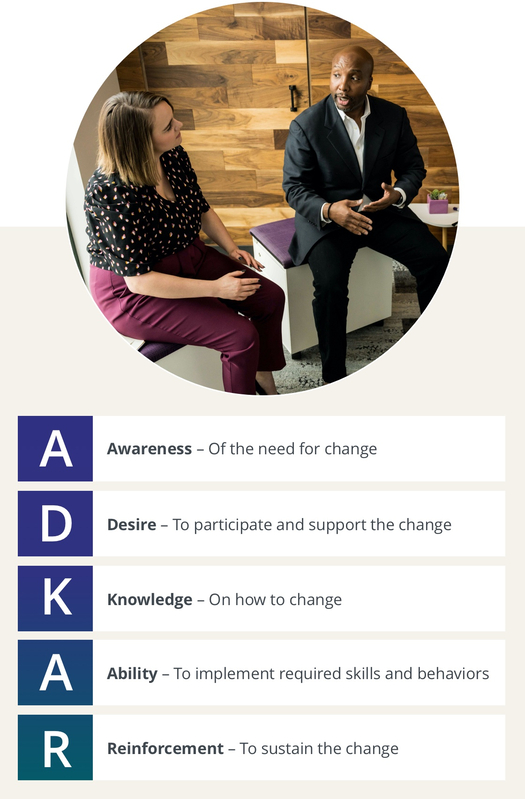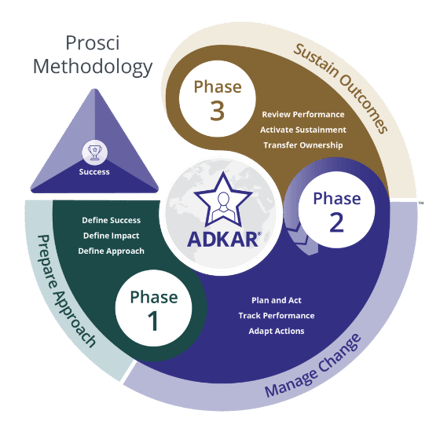Successful Integration Change Management Strategies for M&A
Successful Integration Change Management Strategies for M&A
In mergers and acquisitions (M&A), where two companies combine or one company purchases another, navigating change can be an incredible challenge. This is especially true in blending organizational cultures and ensuring seamless operational integration. M&A change management plays a crucial role in this context, offering strategies to overcome these hurdles.
Between 70–90% of acquisitions fail, highlighting the importance of effective change management for any large organization. Organizations often struggle with merging different corporate cultures during M&A, leading to resistance and inefficiency. Prosci offers targeted solutions to this common challenge, emphasizing the need for a tailored approach to cultural integration.
Based on the renowned Prosci ADKAR® Model, our strategies provide a structured pathway that focuses on uniting different corporate cultures and streamlining operations, making the transition to the future state smoother for everyone involved while improving ROI for the initiative.
By adopting the Prosci Methodology, organizations not only overcome the challenges of M&A but also harness these opportunities for growth and enhanced performance.
Subscribe to our bi-weekly blog to receive articles that help you, your team and your organization grow stronger from change.
Understanding the M&A Change Landscape
Mergers and acquisitions (M&As) are pivotal for any organization and are filled with many challenges. Successfully managing change during these times is key to unlocking the full potential of the merger or acquisition.
Here, we delve into the essential focus areas and actionable strategies to ensure a smooth transition.
Combining company cultures
- Acknowledge diversity – Recognize and celebrate the unique aspects of each company's culture. This recognition serves as the foundation for a cohesive, shared culture.
- Create common goals – Establish shared objectives to unify efforts and provide a common direction.
- Facilitate open communication – Encourage dialogue between networks from both companies to foster understanding and collaboration.
- Action step – Conduct workshops and team-building activities focused on change management during mergers and acquisitions, promoting a unified culture.
Reducing employee worries and resistance
- Transparent communication – Keep employees informed about the merger's progress and how it impacts them directly. Clarity reduces uncertainty.
- Change ambassador networks – Establish support systems like mentors or peer groups to address concerns and questions.
- Acknowledge and reward – Recognize contributions and reassure employees about their value to the organization.
- Action step – Implement regular Q&A sessions and feedback mechanisms to gauge employee sentiment and address concerns proactively.
Aligning strategic directions
- Merge operational aspects – Seamlessly integrate systems, processes and policies to avoid operational costs.
- Clarify objectives and priorities – Ensure that all networks understand the newly merged entity's goals and their roles to help boost revenue and ROI.
- Continuous monitoring and adjustment – Regularly review strategic alignment and adjust as necessary to stay on course.
- Action step – Use frameworks for change management in mergers and acquisitions, like the Prosci Methodology, to guide the integration of business strategies and operational aspects.
Organizations can mitigate common challenges and harness the full potential of the merger or acquisition by addressing cultural integration, employee concerns and strategic alignment with a structured and strategic approach to change management.
The key takeaways? Engage stakeholders to foster buy-in and support. You also want to leverage change management expertise to facilitate smoother transitions, capitalize on growth opportunities, and increase ROI.
Successfully managing change in mergers and acquisitions requires a thoughtful and comprehensive approach. Organizations can transform challenges into stepping stones for success by focusing on these key areas.
The Prosci ADKAR Model in M&A Change Management
The Prosci ADKAR Model is instrumental in M&A change management, providing a structured framework to address the human side of change. It helps engage employees, align different cultures and smoothen integration, making it a valuable tool for successful M&A transitions.
M&A Change Management ADKAR

The ADKAR Model explained
The Prosci ADKAR Model, a cornerstone of effective change management, structures the transition process into five essential stages:
- Awareness of the need for change
- Desire to participate and support the change
- Knowledge on how to change
- Ability to implement required skills and behaviors
- Reinforcement to sustain the change
By covering these critical aspects, the Prosci ADKAR Model offers a comprehensive guide for managing change, from inception to full integration, ensuring each step is thoughtfully addressed and executed.
Applying ADKAR in M&A scenarios
In the context of mergers and acquisitions (M&A), the Prosci ADKAR Model proves particularly effective in managing the complex dynamics of aligning different organizational cultures and streamlining processes.
- Awareness in M&A is about creating a shared vision for the future, emphasizing the strategic reasons behind the merger and its benefits, such as access to new markets or innovation opportunities, and laying the groundwork for understanding and openness.
- Desire transforms this foundation into active support by directly linking the awareness stage to individual and organizational benefits, fostering a positive attitude toward the change.
- Knowledge moves the focus to ensure employees are well-informed about their new roles and the operational dynamics of the merged entities, leveraging examples from targeted training and communications strategies.
- Ability provides practical training and resources, focusing on adopting new systems, processes or technologies, demonstrating how theoretical knowledge is applied practically.
- Reinforcement celebrates achievements and integrates new practices into the organizational culture, illustrating the importance of continuous evaluation and adaptation to ensure the merger's success.
By applying the Prosci ADKAR Model to M&A scenarios, organizations can navigate integration challenges more smoothly, ensuring a successful merger and laying the groundwork for a flexible, resilient corporate culture.

Building Skills With Change Management Certification
The Prosci Change Management Certification Program is designed to equip professionals with the essential skills to manage change effectively in mergers and acquisitions (M&A) scenarios.
This program offers:
- Understanding of the Prosci ADKAR Model – Participants gain insights into applying this model for successful change management.
- Effective communication strategies – The course teaches how to craft messages that resonate and ensure network alignment.
- Resistance management techniques – Learn how to identify and mitigate resistance to change, a critical aspect of any M&A project.
Through interactive sessions, real-world examples, and practical exercises, participants are equipped with the tools to:
- Adopt successful change management practices – Encouraging adoption and implementation of effective change management approaches.
- Develop leadership skills – Enhancing the ability to guide networks through the complexities of M&A, focusing on maintaining morale and productivity.
- Align cultures and integrate processes – A key focus is on merging different organizational cultures and processes smoothly and efficiently.
- Maintain employee engagement – Ensuring employees remain engaged and motivated during transitions.
The certification is not just for immediate benefits in M&A scenarios but also for building long-term internal capabilities. It emphasizes the importance of developing in-house expertise in change management, reducing reliance on external consultants.
It is crucial as organizations often engage in multiple acquisitions over time. Skills and knowledge acquired through this program enhance organizational readiness for future changes, highlighting the Prosci Change Management Certification Program as a tool for equipping staff with the necessary skills.
Methodology for Success in M&A
The structured Prosci Methodology is a proven approach for managing changes in M&A. It combines practical tools and strategies with real-world applications, demonstrating its effectiveness in guiding successful M&A integrations.
Overview of Prosci Methodology
The Prosci Methodology is a comprehensive framework that comprises the Prosci ADKAR Model, PCT Model, and Prosci 3-Phase Process.
The Prosci Methodology includes:
- Assessing change readiness
- Stakeholder engagement
- Communication planning
- Resistance management and more
The methodology also emphasizes the importance of leadership involvement and the need for a structured approach to change.
This systematic approach helps organizations manage the complexities of M&A by providing a clear roadmap for change. It ensures that all aspects of the transition are considered, from the initial planning stages to post-merger integration. The Prosci Methodology also facilitates the alignment of different corporate cultures, which is crucial in M&A scenarios.
By adopting the Prosci Methodology, organizations can navigate the challenges of M&A more effectively, leading to successful integrations and sustained organizational performance.
 Methodology in action: Case studies
Methodology in action: Case studies
The Prosci Methodology has been successfully applied in various contexts, as evidenced by numerous case studies.
For example, in 2015, we helped an academic health system in Chicago merge with two other companies, using Prosci change management strategies to help everyone adapt to a new computer system and work together smoothly. Prosci training helped the team manage the merger and adoption process effectively. As a result, more than 90% of employees were actively involved and supportive, making this the smoothest system update and integration they've ever had. This success story shows how Prosci methods make merging companies and updating systems easier and more efficient.
Another notable example is Prospera Credit Union, a merger of regionally based Canadian credit unions, which adopted the Prosci Methodology to equip individuals across the organization to build a culture of change among influential leaders. Eight employees attended the Prosci Change Management Certification Program, and a Prosci Senior Change Advisor helps to apply the knowledge, skills and tools acquired from the program to their organization.
These case studies illustrate the real-world effectiveness of Prosci methods, showcasing their capacity to enable successful transitions and foster significant change capabilities within your organization.
A Structured Approach to Post-Merger Reorganization
Post-merger reorganization is a critical phase in M&A, requiring a structured approach to ensure successful integration. The Prosci Methodology provides a framework for this, emphasizing the need for effective communication, alignment of cultures, and employee engagement.
Set clear goals
The journey starts by clearly outlining what we want to achieve. It means:
- Sketching out the new company structure
- Detailing everyone's roles and what's expected of them
Communicating these goals is vital. It helps everyone understand their place in the new organization and reduces worries about what's to come.
Blend cultures
Merging companies isn't just about structures; it's about people. We need to:
- Respect and learn from each company's culture
- Find shared values to create a united culture
This step is about celebrating differences and building on commonalities, strengthening the combined company.
Engage employees
For a smooth transition, keeping everyone involved and heard is key. It involves:
- Including employees in planning and decision-making
- Listening to and addressing their concerns
This approach minimizes pushback and builds a supportive atmosphere for the changes.
Track and adjust
Keeping an eye on how things are going lets us fine-tune our approach. It means:
- Monitoring performance against our goals
- Seeking out feedback and acting on it
- Fixing any issues that pop up
Regular check-ins ensure we're on the right path and make necessary real-time adjustments.
By breaking down the process into these digestible steps and leaning on the Prosci ADKAR Model, we navigate the change management during mergers and acquisitions with clarity and purpose, aiming for a seamless post-merger reorganization and successful integration.




